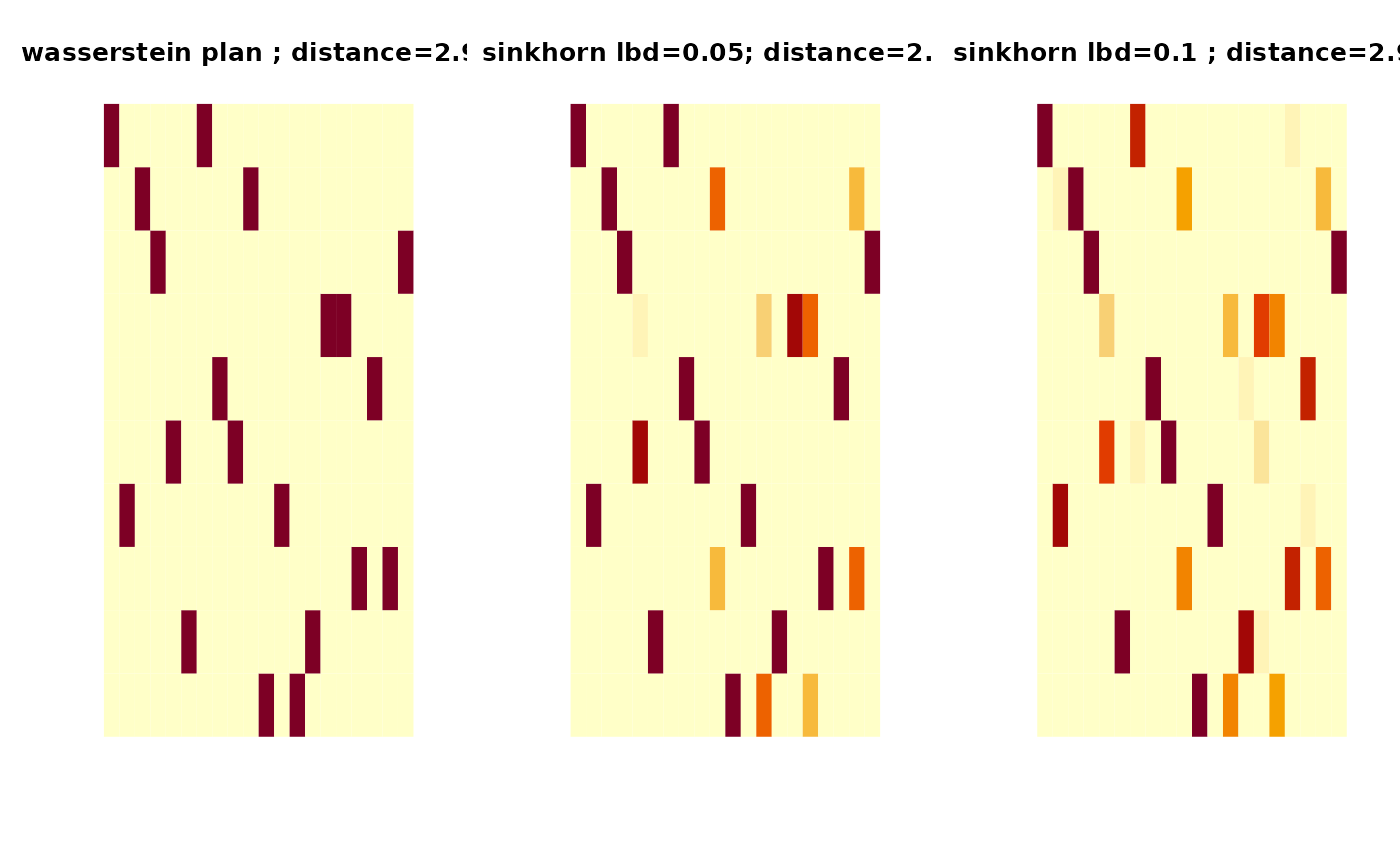
Wasserstein Distance by Entropic Regularization
sinkhorn.RdDue to high computational cost for linear programming approaches to compute Wasserstein distance, Cuturi (2013) proposed an entropic regularization scheme as an efficient approximation to the original problem. This comes with a regularization parameter \(\lambda > 0\) in the term $$\lambda h(\Gamma) = \lambda \sum_{m,n} \Gamma_{m,n} \log (\Gamma_{m,n}).$$ As \(\lambda\rightarrow 0\), the solution to an approximation problem approaches to the solution of a true problem. However, we have an issue with numerical underflow. Our implementation returns an error when it happens, so please use a larger number when necessary.
Usage
sinkhorn(X, Y, p = 2, wx = NULL, wy = NULL, lambda = 0.1, ...)
sinkhornD(D, p = 2, wx = NULL, wy = NULL, lambda = 0.1, ...)Arguments
- X
an \((M\times P)\) matrix of row observations.
- Y
an \((N\times P)\) matrix of row observations.
- p
an exponent for the order of the distance (default: 2).
- wx
a length-\(M\) marginal density that sums to \(1\). If
NULL(default), uniform weight is set.- wy
a length-\(N\) marginal density that sums to \(1\). If
NULL(default), uniform weight is set.- lambda
a regularization parameter (default: 0.1).
- ...
extra parameters including
- maxiter
maximum number of iterations (default: 496).
- abstol
stopping criterion for iterations (default: 1e-10).
- D
an \((M\times N)\) distance matrix \(d(x_m, y_n)\) between two sets of observations.
Value
a named list containing
- distance
\(\mathcal{W}_p\) distance value.
- iteration
the number of iterations it took to converge.
- plan
an \((M\times N)\) nonnegative matrix for the optimal transport plan.
References
Cuturi M (2013). “Sinkhorn distances: Lightspeed computation of optimal transport.” In Proceedings of the 26th international conference on neural information processing systems - volume 2, NIPS'13, 2292--2300.
Examples
# \donttest{
#-------------------------------------------------------------------
# Wasserstein Distance between Samples from Two Bivariate Normal
#
# * class 1 : samples from Gaussian with mean=(-1, -1)
# * class 2 : samples from Gaussian with mean=(+1, +1)
#-------------------------------------------------------------------
## SMALL EXAMPLE
set.seed(100)
m = 20
n = 10
X = matrix(rnorm(m*2, mean=-1),ncol=2) # m obs. for X
Y = matrix(rnorm(n*2, mean=+1),ncol=2) # n obs. for Y
## COMPARE WITH WASSERSTEIN
outw = wasserstein(X, Y)
skh1 = sinkhorn(X, Y, lambda=0.05)
skh2 = sinkhorn(X, Y, lambda=0.10)
## VISUALIZE : SHOW THE PLAN AND DISTANCE
pm1 = paste0("wasserstein plan ; distance=",round(outw$distance,2))
pm2 = paste0("sinkhorn lbd=0.05; distance=",round(skh1$distance,2))
pm5 = paste0("sinkhorn lbd=0.1 ; distance=",round(skh2$distance,2))
opar <- par(no.readonly=TRUE)
par(mfrow=c(1,3))
image(outw$plan, axes=FALSE, main=pm1)
image(skh1$plan, axes=FALSE, main=pm2)
image(skh2$plan, axes=FALSE, main=pm5)
 par(opar)
# }
par(opar)
# }